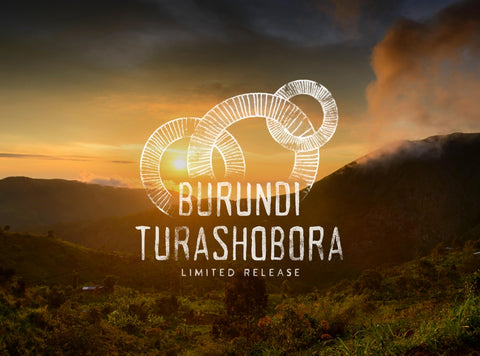
Burundi Turashobora
Roasting in April: Burundi Turashobora
An exceptional coffee with a powerful story is shipping to subscribers of our Small Batch coffee-of-the-month club this April: Burundi Turashobora. We last offered this microlot from an east African women’s growing collective in 2021, and we’re thrilled to have it back.
QUALITY BEGETS EQUALITY
High altitude, abundant rainfall, and volcanic soils create ideal conditions for growing coffee in Burundi. Yet small production and an inconsistent supply chain wasn’t doing the coffee justice in this, one of the poorest countries on the planet. But Burundi native Jeanine Niyonzima-Aroian sought to change that and it started—as many things do—with observation and education.
Working with these farmers, knowing how savvy and how capable they are, I knew that most of them just have not had that little chance. And that chance comes in the form of education. -Jeanine Niyonzima-Aroian
Historically, Burundi women were growing and harvesting the coffee cherries, but it was the male heads of households who would deliver the cherries to the wet mill—and therefore get paid. In encouraging the women to observe by following the production path of their own coffees, these women learned not only better agronomy practices, like nuances of picking at peak ripeness, but also to advocate for getting their own coffee segregated from all the other coffee at the mill. This traceability means ownership of their own coffee lots, and the resultant quality improvement qualifies them for post-harvest premiums. As a result of this transformational change, Jeanine’s company, JNP Coffee, has paid over $250,000 in premiums directly to these farmers.
Improving their coffee’s quality goes hand in hand with improving the equality of the livelihoods of the women farmers who grow it, spreading the profits to all who farm, grow, and harvest.
This value chain became so impactful that, in partnership with International Women’s Coffee Alliance (IWCA) Burundi Chapter and PCI Global, JNP Coffee created a financial literacy program. As a result, within two years these farmers developed a savings program; the money they save is invested in members of their own community, who use those funds to grow their own businesses and return the initial investment, with interest.
The seed money pile grew so big that within two years these women—who had long wanted a processing site of their own for quality assurance—were able to establish their own wet mill—the mill that produced this beautiful coffee. This group of farmers call themselves as Turihamwe Turashobora in Kirundi, which translates to “Together We Can!’’ They became entrepreneurs. They became responsible for their own destiny. They get to reap the benefit of everything they’ve learned, observed, and invested. And their observation of the value chain of their coffee comes full circle: education, investment, opportunity, quality, equality.
TURASHOBORA. WE CAN. AND THEY DID.
It’s an investment you can taste: the aromatics display why Burundi Turashobora has been called ‘a crossroads of Kenyan and Ethiopian coffees’; the telltale perfume-y, flowery fragrance of the best of east African coffees. Tart pomegranate, refined malty tea notes, and an almost honey-like sweetness that elevates each pristine cup.
NOTES FROM THE CUPPING ROOM
“A comforting smell of pumpkin bread…truly a joy to roast.”
Applying finesse to dialing in the times and temperatures is core to any roast, but for East African coffees, it is at least as much art as science. This is where hand roasting really comes to shine. We need to use all our senses to be attuned to when these coffees really hit their mark.
Out of the bag, the beans were stunningly kaleidoscopic, ranging in color from dark pine-green to a paler olive tone. The aromas were equally varied—dry, sweet, spicy, yet with a fresh, celery-like note. Because this is such a small batch, we wanted to do a couple test runs on a comparable coffee first, just to get warmed up. We pulled some Kenyan beans, as they are from a nearby region that produces similar beans, and roasted them to our standard, aiming to hit a roughly 12-minute roast to get to the flavor development and depth of color we like, about 36-40 on the Agtron.
Moving on to the Burundi Turashabora beans, things went reasonably similarly, though first crack was significantly louder than the Kenya. Consensus occurred at about the same temperature, but the rate of rise was harder to control; we were afraid of overshooting the mark. In the end, we cut the burners earlier to slow the rate of rise, allowing us to ease into the final roast.
At completion, the roast exuded a comforting smell of pumpkin bread, before settling into the flowery, pomegranate-like notes that make this coffee so distinctive. This was a fun one to roast, really showcasing how the art of hand roasting brings out the best in a bean. We look forward to the opportunity to having it again.
This is a coffee you want to enjoy for its pure essence. Keep it simple; a pour over will do to bring out its floral and fruity notes. Give it a try before adding any milk and sugar to taste the soul of the bean; you just might like it as is.
-John Nicolini and Michael Madden, Roasters

LIMITED RELEASE PEET’S COFFEES
You might think that a monthly coffee subscription sounds amazing in and of itself, but Peet’s Small Batch coffee-of-the-month takes it a step further. These are microlot coffees, which is why you can only find them at peets.com and you can only access them if you have a subscription. They’re special—their rarity means they can sell out—fast. Subscribing ensures you get to taste each one of these remarkable lots. And if you’re a tried-and-true fan and subscribe to of one of our other coffees or subscription series, not to worry: you can do an add-on of this limited release to your next shipment. At least, while it lasts.


